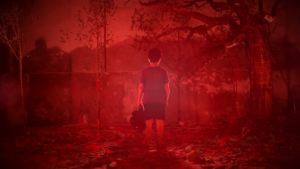Nick Toti’s “Digital Gods”- Season Two, Transmission Two

Artist O.B. De Alessi
I’m going to start this article by revealing my own sexism. If a male artist chooses to go by his initials (i.e. J.D. Salinger or H.R. Giger), I never think anything of it. When a woman does it, it seems indicative of something other than a simple personal choice. I don’t think this is a fair assumption for me to make, but it’s the kneejerk leap my brain takes despite this better judgment. But then, maybe it is fair. Maybe it’s the intended response to the consciously constructed personal identity of an artist. Maybe ignoring it is to brush past an opportunity I’ve been given to consider my own cultural biases. Or maybe it reflects something personally resonant for the artist that has absolutely nothing to do with me or any audience.
These are the complicated thoughts I’m having as I sit down to explore the work of artist O.B. De Alessi…and I’ve only gotten as far as her fucking name! In De Alessi’s case, especially, I think that these are totally valid thoughts. Her work is filled with proddings into her own identity, including overt manipulations of gender and age, as well as subtler performative inquiries of racial and national identity. Even the notion of “authorship” is treated in a playful, inquisitive manner that, while common in certain literary traditions, is relatively uncommon in cinema. Given this context, her choice to go by a gender-ambiguous name is as telling as any other detail. O.B. De Alessi represents the sort of “complete artist” for whom seemingly nothing, including her name, is off-limits from her restlessly creative insinuations.
Before diving into the cinematic work that is my main interest, it should be mentioned that De Alessi’s creative toolkit is quite large. She is a performer, a dancer, an actor, an illustrator, a writer, and more. I was first exposed to her work as a visual artist in two illustrative zines that were published by Kiddiepunk (the small press run by artist/filmmaker and Digital Gods alum Michael Salerno). Her imagery was thematically dark but stylistically playful, with bad-tempered (sometimes murderous) children inspired in equal measure by Michael Jackson, Dostoevski, or Norwegian black metal. Her interests seem totemic; images repeat and ideas ebb and flow with increasingly complex personal meaning every time they return. Like many artists, hers is a body of work that takes on greater meaning when considered as a whole.
I’ve selected a handful of De Alessi’s cinematic works to explore in greater detail.
The Storms and Longing of Oscar Scar
De Alessi’s “Oscar Scar” character was the center of a sprawling, two year long, multimedia project that involved a zine, a blog written from Oscar’s perspective, and this series of videos. My focus here will be limited to the videos, but the other material is worth exploring for anyone interested.
The Storms and Longing of Oscar Scar is a pastiche on the type of personal video diaries that a moody teenager might make. De Alessi plays Oscar, an emo kid who’s primary interests are black metal and ruminating on death and boredom. There are a number of things about this relatively simple/straightforward series that makes it particularly interesting. The most striking element is De Alessi’s performance. She dissolves herself thoroughly into the role of an awkward male teenager with all the “uhhhs” and “ummms” and grasping pseudo-intellectualism you’d expect from this sort of person. Her performance, though, never takes the easy out of lapsing into parody. This is a loving and thoughtful tribute to the subculture of black t-shirted, over-serious sons and daughters of Thanatos. The closest the De Alessi comes to ironic commentary is the use of a cheesy sitcom-style title sequence that plays at the beginning of each episode. It functions as a sort of frame to remind the viewer of the performative nature of both De Alessi and her character.

O.B. De Alessi in ” The Storms and Longing of Oscar Scar”
But my favorite thing about The Storms and Longing of Oscar Scar is the fact that it takes the “teenage emo video diary” as a legitimate genre worthy of serious exploration. Oscar Scar really seems like a mildly fucked up kid just looking to vent his random feelings for whoever happens to click play. The fact that De Alessi is actually an adult woman is inconsequential. Her work here dissolves boundaries between high and low culture, equating video diaries and black metal with Rimbaud and Shakespeare.
White Moon seems more inspired by the writings of Borges than any filmmaker that I’m aware of. It consists only of two scenes ostensibly excerpted from a larger, unreleased (possibly unfinished?) horror film. There is no story, but there is the fragmented suggestion of a story that exists both within and beyond the scope of the actual “movie” itself. For a concise thematic breakdown, De Alessi’s own statement on White Moon is more than adequate:
The two scenes of the fictional film White Moon explore two stereotypes of femininity that came in use predominantly at the end of the 19th century, a period which gave space to fantasy, magic and the study of the occult on one hand, and to psychoanalysis on the other. In this scenario, the female figure in literature and art seemed to be noticeably removed from reality: she appeared above all as the embodiment of male projection of desire and fear. In this context, two main categories could be observed: the femme fatale and the femme fragile: the men murdering Judith/Salome on the one hand and the delicate child-woman Ophelia on the other hand. These two female types, despite looking so different from each other, sprang from the same source, namely male. The gender of the director of the film is not disclosed and is therefore more probably a man, since the “Woman” is, as the main character, the object of desire, the projection of the director’s fantasy.
What makes this work so exciting is the playful relationship it has with its own limitations. De Alessi is unconcerned with the fact that she lacks the resources to create a Zulawski-esque headfuck of a feature-length horror film. She embraces these limitations and creates instead this beautiful sketch of what that film might look like. It’s rare for a filmmaker to place so much trust in her audience’s imagination to fill in the necessary blanks. White Moon suggests an approach to filmmaking that could seriously open up possibilities for filmmakers working with little to no budget.
It doesn’t seem right to describe Kuo’s Eyes as De Alessi’s most “mature” work, despite the fact that, in many ways, it obviously is. On a technical level, it is by far her most accomplished movie to date. It feels wrong, though, to label it as being somehow more “mature,” though, both because the somewhat crude quality of her earlier work is often integral to its design and also because “maturity” seems like an inappropriate gauge by which to judge something as overtly and celebratorily childish as Kuo’s Eyes.
Shot entirely on location in an old, abandoned church in De Alessi’s hometown in Northern Italy, Kuo’s Eyes is equal parts children’s theater and psychological horror film. The location is transformed from scene to scene in ways that are stylized and theatrical. There are bright colors, animal costumes, and a child protagonist whose primary companion is a cute stuffed toy. These innocent trappings are used to tell the dark story of a young boy’s quest to find his eyes after they have been violently cut from his head.

A Still from “Kuo’s Eyes”
Like all of De Alessi’s movies, Kuo’s Eyes succeeds because it understands its limitations and turns them into strengths. Her body of work is one that sees the world for its performative potential and then uses seemingly whatever material is at hand to harness that potential for maximum creative impact. If her work often feels like a sketch or rough draft of something that could have been much larger or more definitive, then it deserves to be celebrated for these qualities. Cinema needs creators whose ideas are bigger than their budgets and De Alessi has been consistently fearless in her disregard for supposed constraints that would have scared off a lesser filmmaker.
For more on O.B. De Alessi, visit her website.
If there are works, dear reader, that should be considered for the Digital Gods column, please share them. If you are a filmmaker/video artist/animator/whatever else whose idiosyncratic/radical/mystical/mind-fucking/ degenerate/unprogrammable/uncategorizable work, please introduce yourself. The call for new work is always open at:
– Nick Toti(@NickTotiis)










